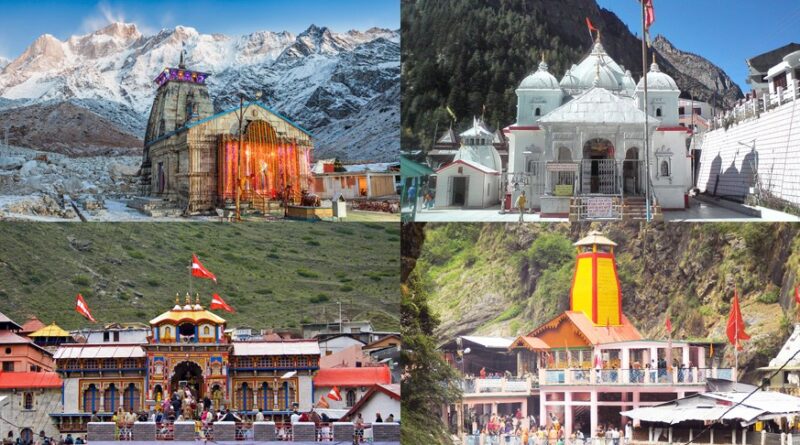Places to Visit during Chardham Yatra
The Chardham Yatra is a revered pilgrimage circuit in the Indian Himalayas, consisting of four sacred destinations: Yamunotri, Gangotri, Kedarnath, and Badrinath. Each of these places holds immense spiritual significance and is surrounded by stunning natural beauty. Embarking on this journey offers not only a deep spiritual experience but also an opportunity to explore some of the most breathtaking landscapes in India. Here’s an extensive guide to these sacred sites and what you can experience at each one: whether you’re planning a Chardham Yatra from Kolkata or any other part of the country.
Yamunotri
Overview: Yamunotri, the westernmost shrine of the Chardham, is dedicated to Goddess Yamuna, one of the seven holy rivers of India. It is located at an altitude of about 3,293 meters (10,804 feet) in the Uttarkashi district of Uttarakhand.
How to Reach: The nearest major town is Hanuman Chatti, which is accessible by road. From Hanuman Chatti, a trek of around 6 kilometers leads to Yamunotri. The trek offers picturesque views of the surrounding mountains and lush greenery.
Key Attractions:
- Yamunotri Temple: The primary attraction, the Yamunotri Temple, is an ancient shrine dedicated to Goddess Yamuna. The temple is situated at the base of the Bandarpunch Peak and is surrounded by snow-capped mountains.
- Surya Kund: A hot spring located near the Yamunotri Temple, Surya Kund is used to prepare prasad (offering) for the deity. Pilgrims cook rice and potatoes in the hot spring, which is a unique ritualistic practice.
- Yamuna River Source: The actual source of the Yamuna River is located further upstream, near the glacier called Yamunotri Glacier. Though the source is not easily accessible, it is revered as a sacred spot.
- Divya Shila: A rock pillar worshipped as a deity, Divya Shila is located at the entrance of the Yamunotri Temple. Pilgrims offer their prayers here before proceeding to the main temple.
Best Time to Visit: The ideal time to visit Yamunotri is from May to June and September to October when the weather is pleasant and the trekking paths are accessible. The shrine remains closed during the winter months due to heavy snowfall.
Gangotri
Overview: Gangotri, located at an altitude of approximately 3,048 meters (10,000 feet), is the source of the Ganges River and holds a special place in Hindu spirituality. It is situated in the Uttarkashi district of Uttarakhand, amidst the majestic Himalayas.
How to Reach: Gangotri is reachable by road from Uttarkashi, which is well-connected to major towns and cities. The journey to Gangotri involves a scenic drive along the Bhagirathi River.
Key Attractions:
- Gangotri Temple: The central attraction of Gangotri is the Gangotri Temple dedicated to Goddess Ganga. This ancient temple, built in the 18th century, is a focal point of devotion for pilgrims.
- Bhagirath Shila: A sacred rock near the Gangotri Temple where King Bhagirath is believed to have meditated to bring the Ganges down to earth. It is a significant site for pilgrims.
- Ganges River Source: The source of the Ganges, known as Gaumukh, is a glacier located around 18 kilometers from Gangotri. The trek to Gaumukh is challenging but offers stunning views of the glacier and surrounding peaks.
- Tapovan: A high-altitude meadow located about 25 kilometers from Gangotri, Tapovan offers spectacular views of the surrounding mountains and is a popular destination for trekkers and nature enthusiasts.
Best Time to Visit: Like Yamunotri, the best time to visit Gangotri is between May to June and September to October. The winter months bring heavy snowfall, making the region less accessible.
Kedarnath
Overview: Kedarnath, situated at an elevation of 3,583 meters (11,755 feet), is one of the twelve Jyotirlingas (sacred shrines) dedicated to Lord Shiva. It is located in the Rudraprayag district of Uttarakhand, amidst the towering peaks of the Himalayas.
How to Reach: The nearest major town is Gaurikund, which is reachable by road from places like Rishikesh and Haridwar. From Gaurikund, a trek of approximately 16 kilometers leads to Kedarnath. This trek is known for its rugged terrain and stunning landscapes.
Key Attractions:
- Kedarnath Temple: The main attraction, Kedarnath Temple, is an ancient shrine dedicated to Lord Shiva. The temple’s architectural grandeur and its location against the backdrop of the Kedarnath range make it a must-visit.
- Vasuki Tal: A beautiful high-altitude lake located about 6 kilometers from Kedarnath Temple. It offers serene surroundings and a picturesque view of the snow-capped peaks.
- Shankaracharya Samadhi: The place where Adi Shankaracharya, the great philosopher and theologian, is believed to have meditated and attained Samadhi. It is located near the Kedarnath Temple.
- Gaurikund: The starting point of the trek to Kedarnath, Gaurikund is known for its hot springs and scenic beauty. It is also believed to be the place where Goddess Parvati meditated.
Best Time to Visit: The ideal time to visit Kedarnath is from May to June and September to October. The area is often closed during the winter months due to heavy snow and adverse weather conditions.
Badrinath
Overview: Badrinath, located at an altitude of 3,133 meters (10,279 feet), is dedicated to Lord Vishnu and is one of the Char Dham’s easternmost shrines. It is situated in the Chamoli district of Uttarakhand, near the banks of the Alaknanda River.
How to Reach: Badrinath is accessible by road from places like Joshimath. The journey to Badrinath involves driving through scenic routes with magnificent views of the Himalayas.
Key Attractions:
- Badrinath Temple: The main attraction, Badrinath Temple, is a significant shrine dedicated to Lord Vishnu. The temple is renowned for its architectural style and the black stone idol of Vishnu enshrined within it.
- Tapt Kund: A sacred hot spring located near the Badrinath Temple. Pilgrims bathe in these thermal waters before visiting the temple as part of their purification ritual.
- Charanpaduka: A holy site located about 1 kilometer from the Badrinath Temple. It is believed to be the place where Lord Vishnu’s footprints are preserved in the form of a stone slab.
- Mana Village: The last village before the Tibetan border, Mana Village is known for its traditional culture and stunning views of the surrounding mountains. It is also believed to be the home of the sage Vyasa.
Best Time to Visit: The best time to visit Badrinath is from May to June and September to October. The winter months bring harsh weather conditions and heavy snow, making the region difficult to access.
Conclusion
The Chardham Yatra is more than just a pilgrimage; it is a journey through some of the most awe-inspiring landscapes in India. Each of the four destinations—Yamunotri, Gangotri, Kedarnath, and Badrinath—offers unique experiences, from the spiritual serenity of the temples to the challenging treks and stunning natural beauty. Whether you are seeking spiritual enlightenment, adventure, or simply a deeper connection with nature, the Chardham Yatra provides a transformative experience that resonates long after the journey ends.




